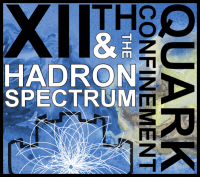Speaker
Description
We analyse the second-class current decays $\tau^{-}\to\pi^{-}\eta^{(\prime)}\nu_{\tau}$
in the framework of Chiral Perturbation Theory with Resonances.
Taking into account $\pi^{0}$-$\eta$-$\eta^{\prime}$ mixing,
the $\pi^{-}\eta^{(\prime)}$ vector form factor is extracted, in a model-independent way,
using existing data on the $\pi^{-}\pi^{0}$ one.
For the participant scalar form factor,
we have considered different parameterizations ordered according to their increasing fulfillment of
analyticity and unitarity constraints.
We start with a Breit-Wigner parameterization dominated by the $a_{0}(980)$ scalar resonance
and after we include its excited state, the $a_{0}(1450)$.
We follow by an elastic dispersion relation representation through the Omn`{e}s integral.
Then, we illustrate a method to derive a closed-form expression for the
$\pi^{-}\eta$, $\pi^{-}\eta^{\prime}$ (and $K^{-}K^{0}$) scalar form factors in a coupled-channels treatment.
Finally, predictions for the branching ratios and spectra are discussed emphasizing the error analysis.
An interesting result of this study is that both $\tau^{-}\to\pi^{-}\eta^{(\prime)}\nu_{\tau}$ decay channels
are promising for the soon discovery of second-class currents at Belle-II.
We also predict the relevant observables for the partner $\eta^{(\prime)}_{\ell 3}$ decays,
which are extremely suppressed in the Standard Model.
Summary
Predictions on the second-class current decays $\tau^{-}\to\pi^{-}\eta^{(\prime)}\nu_{\tau}$
